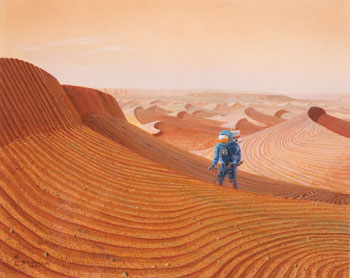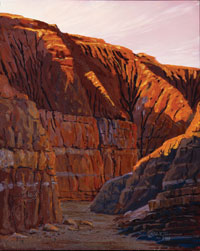 |
||||||||||
|
“Here we are in 2007, but the deepest question of our human existence in
- Bill Hartmann
|
MARS comes to Pittsburgh
Editor’s Note: A scientist and accomplished author and artist, southwestern Pennsylvania native Bill Hartmann was a member of the Mariner 9, Mars Global Surveyor, and European Mars Express imaging teams and was the first winner of the Carl Sagan medal from the American Astronomical Society, awarded for his scientific writing and painting. The author of two novels, “Mars Underground” and “Cities of Gold,” Hartmann is also the author of “A Traveler’s Guide to Mars,” a book that is serving as the inspiration for the new Buhl Digital Dome show at Carnegie Science Center. Hartmann and the team at the Henry Buhl, Jr. Planetarium worked closely on the new show. Thomas Wolfe said you can’t go home again. But I got at least part way there when the team at Carnegie Science Center’s Buhl Planetarium asked me to collaborate on an exciting new planetarium show about Mars. I grew up in New Kensington, Pa., and my parents used to take me to shows at the Buhl, which was then located in a mid-sized building with an enticing dome protruding from the top on the city’s North Side. Among the Buhl’s exhibits was another-worldly scale with a big round dial that looked a lot like the old-fashioned scales that stood in public arcades in the ’40s—where you could get “your weight for a nickel.” But this scale gave you your weight on other planets for free. Little Bill—or “Billy,” as my mother insisted on calling me until I was about 14—always used to step on that scale; and I’d check out my weight on Mars. A year or so ago I arrived back at Buhl Planetarium, now in the high-tech Carnegie Science Center building, to work on the first planetarium show at the new Buhl Digital Dome. There, on the second floor near the door to the revamped planetarium, was “my” old scale—the same one! I stood in Billy’s footprints on the scale and got my weight on Mars (for some reason, it was a lot higher). I had come home again! The Flip Side of MarsWe humans have learned a lot about Mars since the days of the old Buhl Planetarium. When I was growing up, Mars was the mysterious planet that might have canals and a distant civilization. This was an idea proposed in the 1890s by American astronomer Percival Lowell after he and others charted Mars with large telescopes and detected long wispy streaks on the Martian surface. Astronomers of Lowell’s day correctly suspected Mars was somewhat Earth-like, with polar ice caps and deserts, but colder and drier. Lowell proposed that intelligent Martians had built canals to bring water from the polar ice caps down to their cities on the warmer equator. In response, H. G. Wells (not Tom Cruise or Steven Spielberg) created the 1890s tale “The War of the Worlds,” in which Lowell’s Martians invaded Earth only to be defeated not by our grandest armies but by lowly terrestrial bacteria. By the time I was in grad school in 1964, however, the American spacecraft Mariner 4 had whizzed by Mars and got the first fuzzy close-up pictures of the planet. No canals, no cities, no Martians. The handful of pictures showed only a cold, dry, dusty world with lunar-like impact craters. By 1970, many scientists thought Mars was a lost cause, biologically speaking. As one of the first young Ph.D.s in the new field of planetary science, I had the great fortune in 1971 to be on the imaging team of the Mariner 9 orbiter, the first probe to orbit Mars and map the planet in photographic detail. Amazingly, we discovered that arid Mars not only had enormous volcanoes, lava flows, sand dunes, and polar ice fields, but it also was laced with dry riverbeds! Mariner 4 had missed this because, by chance, it photographed only the most boring, cratered, moon-like side of Mars.
Suddenly Mars was intriguing again! If it had dry riverbeds, it must have had substantial amounts of surface water at one time. Some scientists, noting that many of the riverbeds emptied into low northern plains, speculated that early Mars must have had seas, or at least water-filled crater lakes. Where was the water now? Perhaps, after all, early Mars really did support life until the water dried up.
A New RaceThe race was on again to go to Mars; to land probes and get pictures of the surface. In the 1970s, the Soviets sent the first couple of landers to Mars, but they all crashed. Our NASA team placed the first two working probes on Mars in 1976. What did we find on the surface this time? No plants, no animals. Only starkly beautiful sand dunes and boulders under a greyish-pink sky. The surface soils tested sterile, but that seemed to be because the Martian atmosphere, lacking an ultraviolet-blocking ozone layer, allowed strong solar ultraviolet rays to reach the ground and sterilize the exposed dust and rocks. Further mapping with photos from orbiters raised the stakes. The data indicated that a few hundred yards under the sand and rock, Mars harbored massive underground ice, like that in the Arctic tundra of Canada. This supported the idea that primordial Mars resembled primordial earth, and that both planets had abundant liquid water—thought to be an essential requirement for fostering life. The water sank into the ground and froze.
Finding Mars—On EarthWhy should we care whether Mars ever spawned life? The question of whether life ever got started there is a perfect scientific question because either answer is profound. If we prove that life—even the simplest bacteria—ever evolved on Mars, it would show we are not alone in the universe. Millions of planetary systems exist among the stars in our galaxy, and if both Earth and Mars spawned life in our system, then it’s a safe bet that many advanced life forms exist in the cosmos. Mars might even allow us to start investigating whether life follows the same molecular course on all planets. On the other hand, if we prove that life never started on Mars, in spite of an early water-rich environment, then we have to ask, “Why not?” That could lead to a view that we really are alone in the universe. Mars thus beckons us to new explorations to find out about our human role in the universe—our own uniqueness. Some researchers thought we might learn more about origins of life on Mars if only we could get some rocks from the red planet and examine them close up, in the lab. And by the 1980s, scientists realized—almost with chagrin—that we do have such rocks! They lay in museums among collections of meteorites. These rocks were blasted off Mars when asteroids struck the planet millions and millions of years ago. After orbiting around the sun, those rocks eventually collided with Earth. The rocks themselves are mostly basaltic lavas, formed in the last quarter of Martian history—evidence that volcanism on Mars is not a relic of the past, but is continuing in the present. The youngest group of Martian meteorites were blasted out of a Martian volcanic desert “only” 170 million years ago—within the last five percent of Martian history. Today’s QuestionsDid the Martian rocks answer the question about life? Not quite. Proof of young volcanism means that volcanic magmas sporadically melted the underground ice throughout Martian history, creating at least sporadic water supplies and perhaps explaining the rivers. Amazingly, one respected NASA team announced in the 1990s that they had found possible fossil microbes in carbon-rich deposits in one Martian meteorite. A modest majority of Mars scientists appear to believe they are wrong, but their work points to the possibilities. Conceivably, what they detected might be “missing molecular or bacterial links” on the road to life—links long ago destroyed on dynamic, erosion-rich, chaotic, life-filled Earth. Was early Mars, then, like early Earth? Was it habitable? Most scientists today believe that Earth’s life evolved in watery or moist environments. Ongoing DNA studies suggest we are all descended from bacteria that evolved in high-temperature hot springs. Mars had water, volcanism, and must have had abundant geothermal pools. So could life have evolved there, after all? Recent French and American studies have proven that Mars experiences dramatic climate changes because—unlike Earth—its polar axis wobbles and leans toward the sun every 10 million years or so. This burns ice off the poles, increases water vapor in the atmosphere, and leads to fresh snow and ice deposits at midlatitudes. Consistent with this theory, American researchers in 2001 discovered that many mid-latitude Martian hillsides have fresh-looking, 10-by-200-yard erosion gullies, apparently caused by episodes of running water. In 2006, the same team showed examples of fresh deposits in these gullies within the last decade —raising the likelihood that even modern Mars may see sporadic water releases. Thus, from 1965 until today, the trend of research has been to raise dramatically the chances that Mars may tell us something about whether moist environments can harbor life. Here we are in 2007, but the deepest question of our human existence in the universe remains unanswered after 10,000 years of human wonderment: Do alien creatures or even intelligent civilizations exist elsewhere in the universe, or is life a unique, special creation only on Earth? Mars orbiters from both Europe and the United States and two Mars rovers landed by the U.S. space program are currently seeking answers. More launches are scheduled, and planning for human exploration has been funded. We’ve come a long way since young Billy stepped on that scale at Buhl Planetarium.
|
|||||||||
Pittsburgh Glass · Time to Play · A New, More Personal Jesus · Special Supplement: Thanks to Our Donors · Director's Note · NewsWorthy · Now Showing · Face Time: Anthony Rothbauer · About Town: Art Imitating Life · Field Trip: On the Road with Douglas Fogle · Science & Nature: Working the Bones · Artistic License: The Traveling Factory · First Person: A Traveler's Diary · Another Look: Sol LeWitt Drawings
 |
Copyright © 2017 CARNEGIE Magazine. All rights reserved. |




